Christ is born! Glorify Him!

Here’s the point of this Post:
In traditional Western Christianity, Saint Joseph gets his due. In Eastern Christianity, Saint Joseph almost gets the brushoff, and I think we need to do better by him.
If you’re busy (returning presents, perhaps?) you may stop reading now, if you wish.
However, if you want the evidence:
The feast of Saint Joseph is observed by Roman Catholics on March 19 – and also with less diligence by some Anglicans and Lutherans.
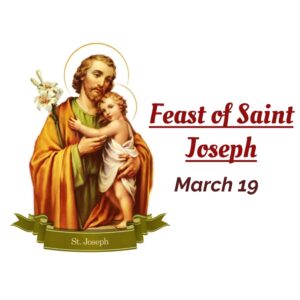
In addition, in 1955 Roman Catholics added May 1 as the Feast of Saint Joseph the Worker. In Mark 6:3 and Matthew 13:55 Joseph iis called a τέκτων (“tektōn”), usually translated into English as “carpenter”, but it equally means “craftsman”. Thus the Roman Church makes use of Saint Joseph to emphasize the value of work, especially of “ordinary” (though not ordinary) workers who provide necessary services which those working in offices or sitting in boardrooms or writing Blogs can never provide. * A brilliant move on their part, or so I think.
- For example, at this time of year, USPS, FedEx and UPS men and women who worked so hard to get packages delivered in time for Christmas. If you ever catch one before they hurry away, please say “thank you”.
Question: When is Saint Joseph’s Day in the Orthodox Church?
Answer: We don’t have one.
Question: Do we Orthodox ignore Saint Joseph entirely?
Answer: Not quite.
On the Sunday before the Nativity, we hear about him in our Gospel reading (Matthew 1:1-25).
I’m sure you’ve heard priests or deacons stumble over this, or make up prununciations as they go along. Beginning with Abraham, the lineage of Jesus is traced all the way to “Jacob the father of Joseph”… and then comes the “kicker”, so to speak: Joseph was not the father of Jesus!
Matthew’s account of the birth of the Savior came somehow from Joseph, for it tells the story from his viewpoint: Joseph was distressed to find Mary pregnant, but an angel told him the truth of the matter. The angel directed Joseph to name the Baby “Jesus”, and he did so. An angel warned Joseph to flee with his Family to Egypt, and then to return. Joseph was warned in a dream to avoid Judaea and to take them to Nazareth. Surely Joseph, this faithful man was chosen by God just as much as was the Virgin Mary. He must have been a devout man, in order for him to have been open to these angelic messages.
Question: So do we Orthodox have a Troparion for Saint Joseph, this worthy man?
Answer: No.
However, on the Sunday after the Nativity he does share one with a few other beings, bodiless and otherwise. The only video I could find comes from the Melkites (Eastern Rite Roman Catholics): it’s the same as ours.
Proclaim, O Joseph, to David, the ancestor of God, the great miracles: you have seen a Virgin great with child; you gave praise with the shepherds, adored with the Magi, and the angel has appeared to you. Intercede with Christ God to save our souls.
Question: Do we Orthodox traditionally have icons of Saint Joseph together with the Virgin Mary and the Infant Jesus?
Answer: No.
Western artistic representations of the Nativity of our Lord usually have Joseph right in the middle of things, as surely he must have been.
Aren’t these lovely?
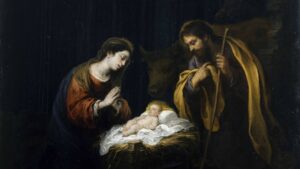

It’s the same with our modern Nativity sets and Christmas cards.
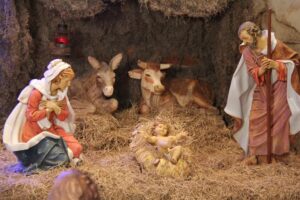
There are a few modern icons of a similar sort. Whether they’re actually of Orthodox origin I don’t know. For example:
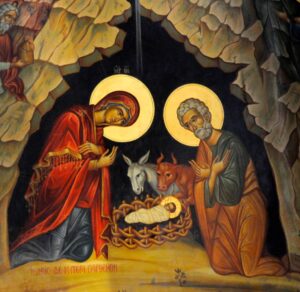
Question: Do we Orthodox traditionally have icons of Saint Joseph the Betrothed alone with the Christ Child?
Answer: No.
A few contemporary ones exist (most of Roman Catholic origin, I think) but, so far as I can find, the Orthodox Church traditionally has none.
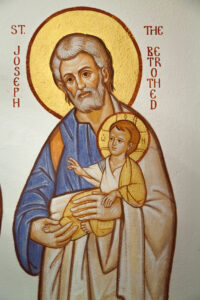
Question: In traditional Orthodox icons of the Nativity where do we find Joseph?
Answer: In no obvious place!
He’s ‘way down at the bottom of the icon, looking dejected, being talked to by… whom? Probably Satan or one his fallen angels in disguise. No one seems sure.
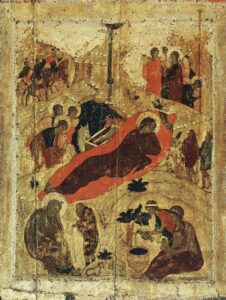
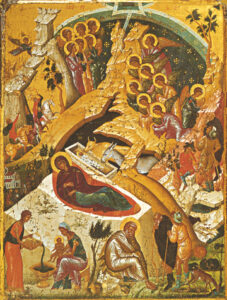
What’s he doing down there?
Before we answer that, keep in mind that genuine Orthodox icons are not intended to be realistic. This is particularly true of Festival icons, which tell the story of the Feast. Thus our Lord Jesus is depicted twice: once in the manger, then below being washed up after His birth. Or again, the Mother of God is usually shown, not lovingly holding her Baby as surely she did, but rather sadly looking off into space. Already she is in dread, foreseeing what lies ahead for her little Boy.
[An art critic described the traditional Orthodox Nativity icon as: “Have yourself a gloomy little Christmas”!]
Joseph is separated from the goings-on in the cave to symbolize that he was not the father. Also there was good reason for him to feel anxious, confused: “What have I got myself into? All I was supposed to be was guardian to this young girl. Suddenly I am head of a Family consisting of the Mother of God! and the Son of God! – and me. How am I supposed to lead a Family in which I am definitely not – and will never be – at the center of things, where I’m always in third place? It’s impossible. And I’m an old man. I can’t handle this…”
But he did.
Question: Do we Orthodox traditionally allow Saint Joseph to appear in icons after the Nativity?
Answer: Only three, all of them Scriptural:
1) When the Infant Jesus is presented in the Temple, forty days after his birth, Joseph is present but stands behind and says nothing, does nothing.
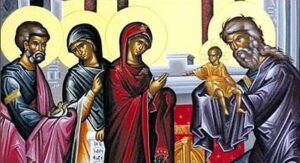
2) In proper depictions of the Flight into Egypt, Saint Joseph always leads from behind, again symbolizing his place in the Holy Family.
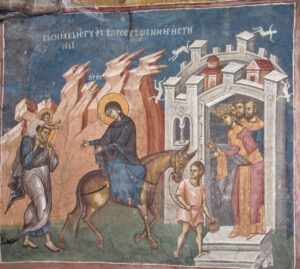
The Coptic (Egyptian) Orthodox Church celebrates the Feast of our Lord’s Entry into Egypt on the 24th day of the month of Bashans, which is June 1st.
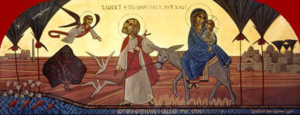
_____________________________
Now, before we come to the third instance, may we have an imaginative interlude?
What was life like in their home in Nazareth after their return? Let me quote (as I also did last August) from the late Fae Melania in her little book The Quantity of a Hazelnut. This lovely piece of writing suggests how it must have been.
“There is a story that Jesus, when He was a child, played at making birds out of clay, and when He tossed them into the air, they flew. Well, I don’t believe that. There is another version of His childhood that I believe even less: that sob story about the despised carpenter’s family, outcast, poor, hungry, cold and sad. Nobody despises carpenters nowadays, and I’m sure they didn’t then, either, not in that little peasant backwater. … if everyone else was eating, I think the Holy Family was, too.
I have a different idea of what it must have been like in that Holy Household. He didn’t make birds, but He first, since Adam, named them.
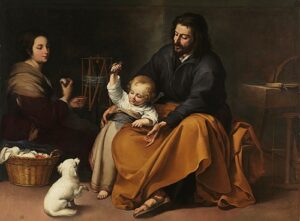
Imagine what it was like watching Him grow, seeing His infant eyes first discover a bird and, in delighted recognition, know its nature. What a blazing light of reality must have grown in that House as His world widened, as He saw and touched and handled the common things of the visible world. How the fire must have leapt, how the wood of the table must have shone in the sunlight, how water must have sparkled in the pail, how stone and earth must have described geology. And the flowers beside the door, the wild flowers beyond, the fig tree, the olive, the vine, with what a light they must have burned when the light of His eyes touched them. How the birds must have sung and the cat purred, and lambs played. Goats, too, rabbits, butterflies, caterpillars, field mice, little lizards, garden snakes, the ox and the ass, the hen with her chicks, all struck with the lightning of His glance, their natures known and revealed
How the hearts of Mary and Joseph must have sung, to see the unchanged world in its charged beauty, seeing as He saw.
Those were the hidden years, one with the earth’s sweet being in the beginning, Eden in Nazareth. Then He was daily God’s delight, rejoicing always before Him.”
___________________________
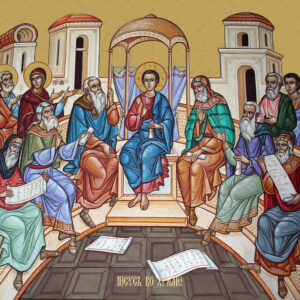
3) Very occasionally Saint Joseph (along with the Theotokos) appears in the icon of The Boy Jesus Teaching in the Temple. (Note here at the extreme left.)
Luke 2:41-50: “His parents went up to Jerusalem every year at the Feast of the Passover. And when He was twelve years old, they went up to Jerusalem according to the custom of the feast.”
Twice the story tells us – why is this so rarely noticed? – how very well Joseph succeeded at his task.
On their way home, after three days they realized Jesus was not with the crowd returning to Nazareth. * He must have been a gregarious independent Boy.
- Imagine, if you can, a society where you could lose your child in a crowd and not worry about it for three days, just assume he was ok.

After looking all over they found Him in the temple, very much at home with the teachers and scholars there. Mary scolded Him (Imagine scolding God Incarnate!): “Son, how could you treat us like this? Your father and I have been anxious, looking for you.”
That is the line I’m chasing here. “Your father and I…” Did they doubt the Virgin Birth? Of course not. Mary and Joseph knew who His real Father was. In Luke’s Gospel, we just heard about it in detail. Nevertheless it just rolled off her tongue: “Your father and I have been anxious…”
And then when He explained to them “I must be about My Father’s business”, it says “they did not understand what He was saying”!
“Then He went down to Nazareth with them and was obedient to them.”
What an extraordinarily good father Joseph must have been to Mary’s Son, so that He was also “Joseph’s Son”, so that the Son of God would be obedient to him.
Joseph, a truly humble man who guided Jesus all through His childhood, spent time with Him, taught Him to be a carpenter, a craftsman like himself. We know that because in Mark 6:3 and Matthew 13:55, when the people of Nazareth saw Jesus soon after He began His ministry, they asked “Isn’t this the carpenter? the craftsman?”
But his Boy Jesus grew up to be a craftsman of souls.
______________________
My opinion:
The Holy Orthodox Church makes far too little of Saint Joseph.
At this time in history when the nuclear family is so unsteady, here is the Church’s First Family. Today when the specific role of fathers is not well understood and is often downplayed, here is Saint Joseph, a man who knew how to be a good father under the most difficult, confusing and challenging circumstances. We Orthodox make too little of him. And of them.
Are icons of the Holy Family acceptable in the Church? I’ve read the arguments which say they are not, because they downplay the Virgin Birth of the Theotokos and appear to make Joseph a husband and father in the usual sense. * Or perhaps because they portray a Family such as no one else could aspire to.
- For example: https://www.johnsanidopoulos.com/2015/12/the-heretical-icon-of-holy-family.html), written by a man whom I respect very much.
All I can say is that I’m not convinced that Holy Family icons are wrong,
As we’ve seen, Joseph was guardian of the Family in the usual sense. He played the role of father to Jesus in the usual sense. In speaking to Jesus, the Ever-Virgin Mary referred to him as “your father…” Why should not the Holy Family be held up as an ideal? in how they lived and loved and conducted themselves.
Orthodoxy is not bound by dead Tradition, but rather lives by The Tradition. Our “classic” Nativity icons did not exist during the early centuries of the Church *, but rather were produced over time – even drawing on pagan styles and patterns – to meet the needs of the Church then.
- See this excellent article by the same John Sanidopoulos: https://www.johnsanidopoulos.com/2018/12/origins-of-icon-of-nativity-of-christ.html

Then why not Orthodox icons of the Holy Family to meet the needs of today? * – to be drawn out of the rich treasure-house of the Church’s Tradition, which certainly includes the Holy Family of Jesus, Mary and Joseph.
- However, as I search the internet, I find almost no Holy Family icons that I think are well “written”. Western though it is, at least the image to the right is good art.
Likewise, today when “ordinary” work is often downplayed in our society – folks, we’re running very short of plumbers and electricians and skilled craftsmen of many sorts – here is Saint Joseph the Craftsman to lead the way. I think we Orthodox should emphasize him more. That is in no way to denigrate Mary or her Virgin Birth… but is Joseph himself a saint or is he not? Then why not good Orthodox icons of him?.

Those are my opinions.
_______________________
Back to the Gospel story, or rather lack thereof, for after Jesus’ twelfth birthday, we never hear of Joseph again. We know only that from the Cross Christ gave His Mother into the care of John – which meant that Joseph had died. When? We do not know. Where was he buried? We do not know. Naturally, at the time no one thought to take note of his relics.
So to the original question:
“Where’s Saint Joseph?”
I think we know where he is now. At least, I can imagine only one answer.
When our Lord Christ descended into hades to rescue the dead, I cannot help but think that when He first saw Joseph, He said to him, “Father!” And that Joseph said to Him, “My Son!”
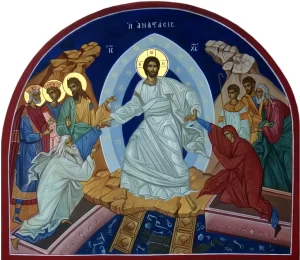
In the Church’s Resurrection Icon, the figures which surround the Risen Christ vary from one icon to another. Is it possible that the white-bearded old man who sometimes is to the Lord’s left is Joseph? (Does anyone here present know?)
No matter, Saint Joseph the Betrothed now lives forever in glory with his Son, his “Foster Son” who is also his Lord and his God.
Next Week: What happened between the Epiphany and the Sunday after the Epiphany
Week after Next: Wisdom from Saint Gregory of Nazianzus
This was a wonderful essay, Father. My parents are Roman Catholic, and they noted that 2021 was dedicated to St. Joseph.
https://www.vaticannews.va/en/pope/news/2020-12/pope-francis-proclaims-year-of-st-joseph.html
Fr. Bill, this was a great read, I always wondered why Saint Joseph wasn’t getting his due in the Orthodox Church. I pray for his Intercessions especially when I am having anxiety and bad thoughts as I am sure he struggled with it. Glory to God!
Thank you, Zach. I am so old and write so much that I forget most of it. So I went back to Post 363 and read it and say, in all humility, that I enjoyed it very much! I think I’ll repeat it on the Sunday after the Nativity.